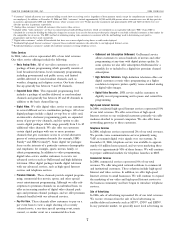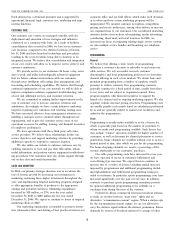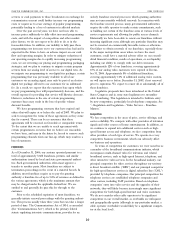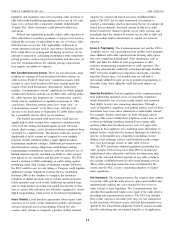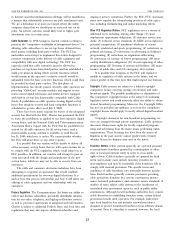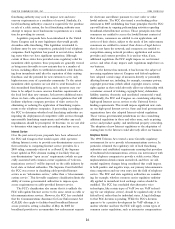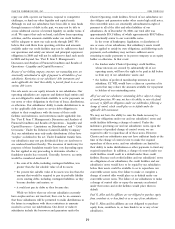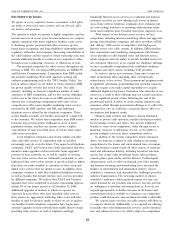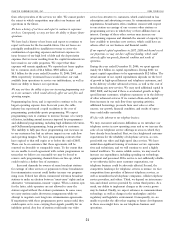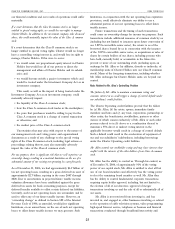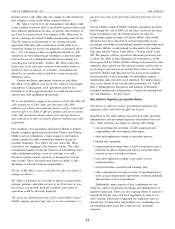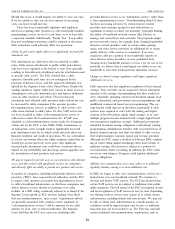Charter 2006 Annual Report Download - page 31
Download and view the complete annual report
Please find page 31 of the 2006 Charter annual report below. You can navigate through the pages in the report by either clicking on the pages listed below, or by using the keyword search tool below to find specific information within the annual report.
CHARTER COMMUNICATIONS, INC. 2006 FORM 10-K
and universal service obligations to alternative voice technology. resolved and how they will affect our potential expansion into
Also, the FCC and Congress are considering whether, and to telephone service.
what extent, VoIP service will have interconnection rights with Employees
local telephone companies. The FCC has already determined As of December 31, 2006, we had approximately 15,500 full-
that providers of telephone services using Internet Protocol time equivalent employees. At December 31, 2006, approxi-
technology must comply with traditional 911 emergency service mately 100 of our employees were represented by collective
obligations (‘‘E911’’) and it has extended requirements for bargaining agreements. We have never experienced a work
accommodating law enforcement wiretaps to such providers. It stoppage.
is unclear how these regulatory matters ultimately will be
ITEM 1A. RISK FACTORS.
Risks Related to Significant Indebtedness of Us and Our Subsidiaries (make us vulnerable to interest rate increases, because
approximately 22% of our borrowings are, and will continue
We and our subsidiaries have a significant amount of existing debt to be, at variable rates of interest;
and may incur significant additional debt, including secured debt, in
(expose us to increased interest expense to the extent we
the future, which could adversely affect our financial health and our
refinance existing debt with higher cost debt;
ability to react to changes in our business.
(adversely affect our relationship with customers and
We and our subsidiaries have a significant amount of debt and suppliers;
may (subject to applicable restrictions in our debt instruments)
(limit our ability to borrow additional funds in the future,
incur additional debt in the future. As of December 31, 2006,
due to applicable financial and restrictive covenants in our
our total debt was approximately $19.1 billion, our shareholders’
debt;
deficit was approximately $6.2 billion and the deficiency of
earnings to cover fixed charges for the year ended December 31, (make it more difficult for us to satisfy our obligations to the
2006 was $1.2 billion. holders of our notes and for our subsidiaries to satisfy their
As of December 31, 2006, approximately $413 million obligations to their lenders under their credit facilities and
aggregate principal amount of Charter’s convertible notes was to their noteholders; and
outstanding; which matures in 2009. We will need to raise
(limit future increases in the value, or cause a decline in the
additional capital and/or receive distributions or payments from value of our equity, which could limit our ability to raise
our subsidiaries in order to satisfy this debt obligation. An additional capital by issuing equity.
additional $450 million aggregate principal amount of Charter’s
convertible notes was held by CCHC. A default by one of our subsidiaries under its debt
Because of our significant indebtedness, our ability to raise obligations could result in the acceleration of those obligations,
additional capital at reasonable rates, or at all, is uncertain, and which in turn could trigger cross defaults under other agree-
the ability of our subsidiaries to make distributions or payments ments governing our long-term indebtedness. In addition, the
to their parent companies is subject to availability of funds and secured lenders under the Charter Operating credit facilities and
restrictions under our subsidiaries’ applicable debt instruments the holders of the Charter Operating senior second-lien notes
and under applicable law. If we need to raise additional capital could foreclose on their collateral, which includes equity interest
through the issuance of equity or find it necessary to engage in in our subsidiaries, and exercise other rights of secured creditors.
a recapitalization or other similar transaction, our shareholders Any default under those credit facilities or the indentures
could suffer significant dilution, and in the case of a recapitaliza- governing our convertible notes or our subsidiaries’ debt could
tion or other similar transaction, our noteholders might not adversely affect our growth, our financial condition, our results
receive principal and interest payments to which they are of operations, and our ability to make payments on our
contractually entitled. convertible notes, Charter Operating’s credit facilities, and other
Our significant amount of debt could have other important debt of our subsidiaries, and could force us to seek the
consequences. For example, the debt will or could: protection of the bankruptcy laws. We and our subsidiaries may
incur significant additional debt in the future. If current debt
(require us to dedicate a significant portion of our cash flow
levels increase, the related risks that we now face will intensify.
from operating activities to make payments on our debt,
reducing our funds available for working capital, capital The agreements and instruments governing our debt and the debt of
expenditures, and other general corporate expenses; our subsidiaries contain restrictions and limitations that could
significantly affect our ability to operate our business, as well as
(limit our flexibility in planning for, or reacting to, changes
significantly affect our liquidity.
in our business, the cable and telecommunications indus-
tries, and the economy at large; The Charter Operating credit facilities and the indentures
(place us at a disadvantage compared to our competitors governing our and our subsidiaries’ debt contain a number of
that have proportionately less debt; significant covenants that could adversely affect our ability to
17


